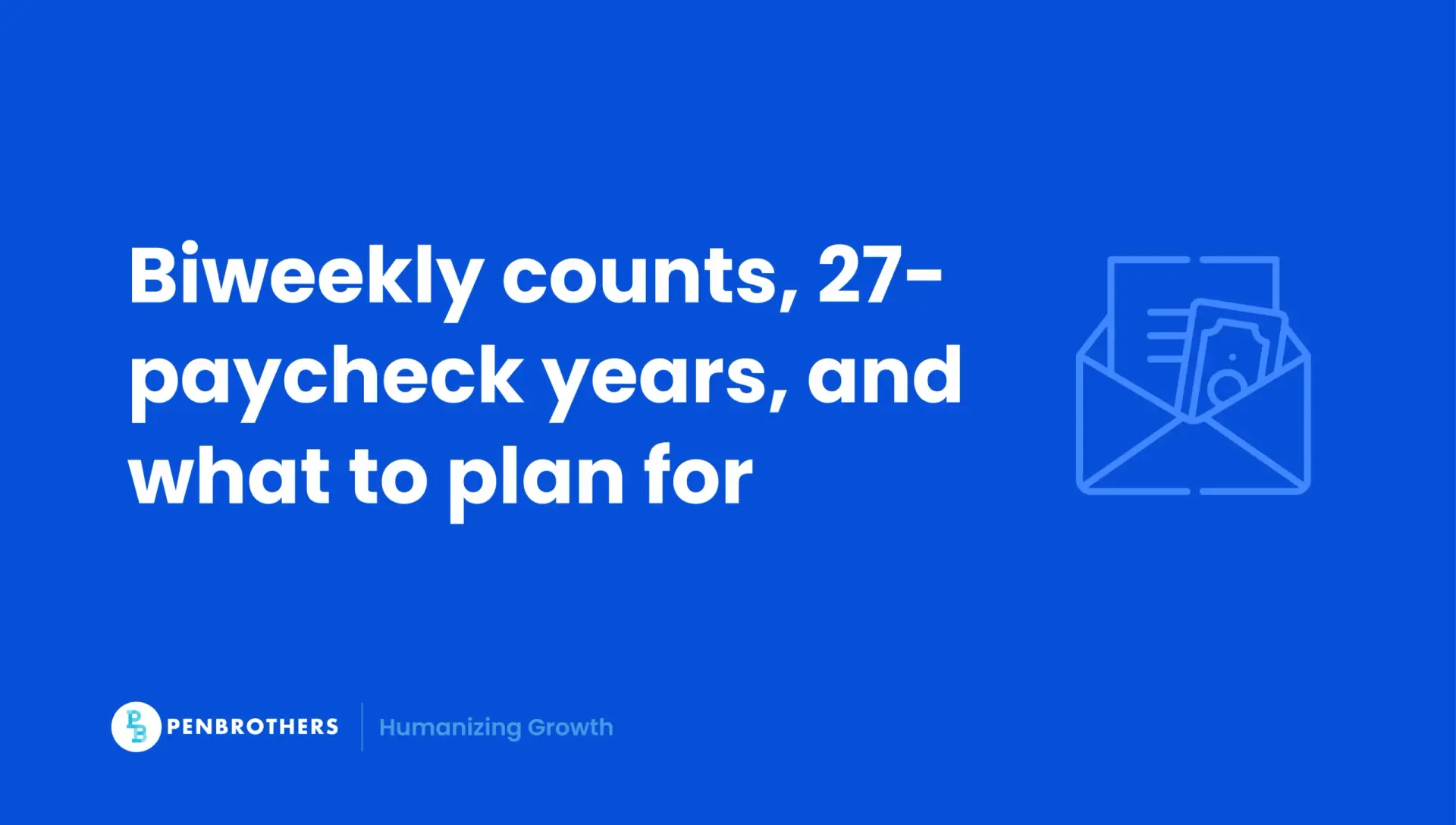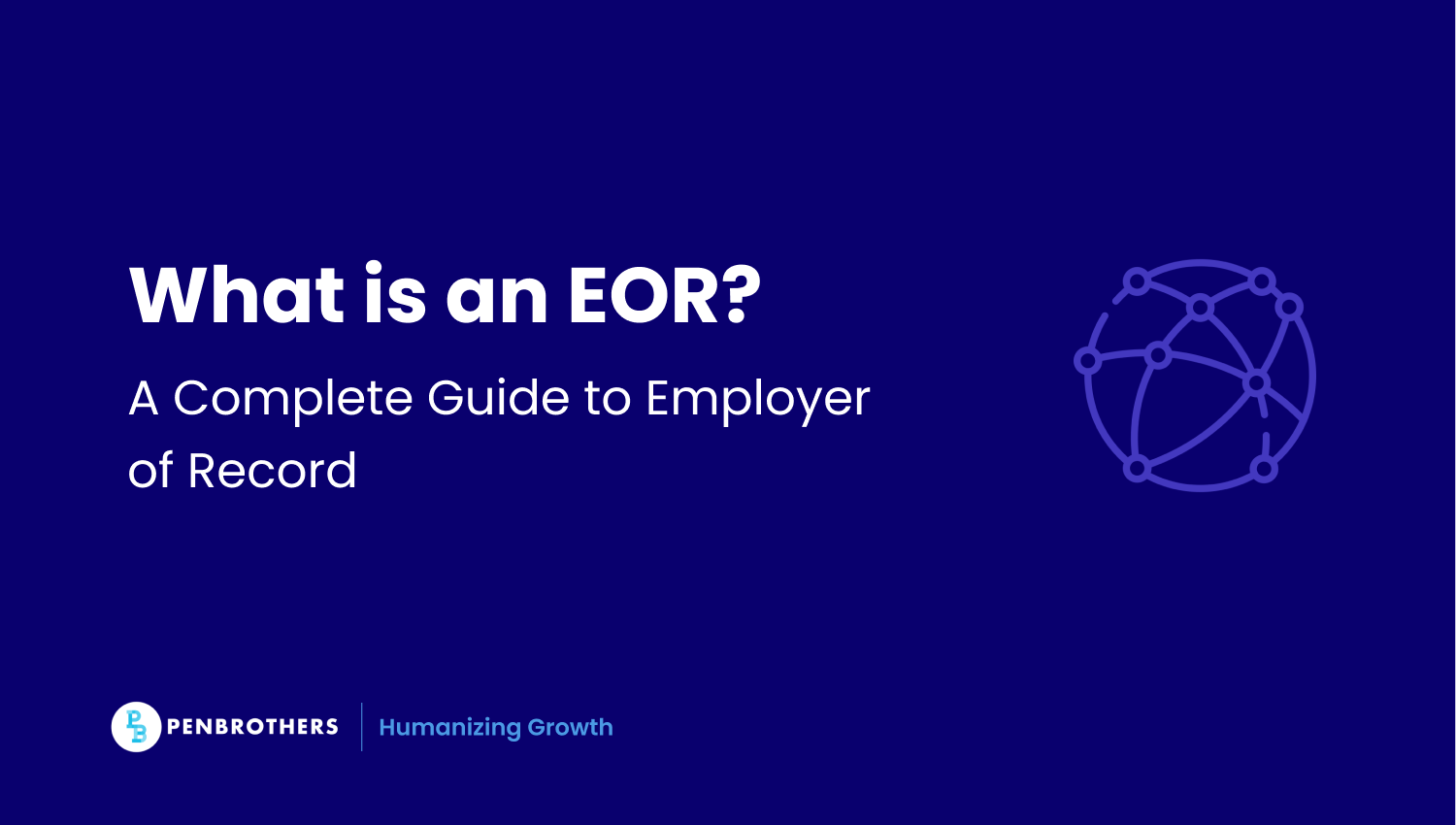What's Inside?
How Many Pay Periods in a Year? The 2025–2026 U.S. Guide

The number of pay periods in a year depends entirely on how often you pay people. Weekly, biweekly, semimonthly, monthly. Most U.S. employers land on biweekly, which usually gives you 26 pay periods. Except when it doesn’t. Some years, the calendar aligns just right and you get 27.
For 2025, biweekly schedules produce 26 periods. Clean. Simple.
For 2026, most employers will see 26 again, but if your first paycheck lands on January 2, you’re looking at 27.
Key Takeaways
- Pay Frequency Determines the Number of Pay Periods: The total number of pay periods in a year is entirely dependent on a company’s chosen pay frequency. The most common schedules in the U.S. are weekly (52 periods), biweekly (26 or 27 periods), semimonthly (24 periods), and monthly (12 periods).
- The “27 Paycheck” Year is a Calendar Anomaly: A biweekly (every two weeks) pay schedule typically results in 26 pay periods. However, because a year has slightly more than 52 weeks (365 days / 14 days = 26.07), a 27th pay period will occur in some years. This happens when the year’s first paycheck lands on the very first or second day of the year.
- 2025 Will Have 26 Biweekly Pay Periods: For 2025, the calendar alignment makes a 27th biweekly pay period mathematically impossible, regardless of which weekday an employer pays on. Businesses can confidently budget for 26 pay periods.
- 2026 May Have 27 Pay Periods for Some Employers: For 2026, employers who pay every other Friday and whose first paycheck of the year lands on Friday, January 2, 2026, will have 27 pay periods instead of the usual 26. Employers with different pay dates will likely only have 26.
Pay Frequency Basics
What Is a Pay Period, and Why It Matters
A pay period is just the recurring window of time you use to track work and cut checks. How often that window repeats is your pay frequency. The day funds actually hit accounts is the pay date. These three things, period, frequency, and date, set your entire payroll rhythm. They shape cash flow, and they determine how many times a year you process payroll.
Typical U.S. Frequencies, at a Glance
Table 1. Frequency vs. Pay Periods per Year
| Pay Frequency | Pay Periods Per Year |
| Weekly | 52 |
| Biweekly | 26 (occasionally 27) |
| Semimonthly | 24 |
| Monthly | 12 |
How Many Biweekly Pay Periods in a Year
Biweekly pay typically yields 26 periods. Clean math. But sometimes, depending on how your chosen pay day lines up with January 1st, you’ll see 27.
Why 27 Paychecks Happen
A year has 365 days. A biweekly period spans 14 days. Do the division and you get 26.07 periods. That leftover fraction doesn’t vanish. It accumulates. Year after year, those extra hours and minutes pile up until they form one complete 14-day period that fits entirely within a single calendar year. If your first paycheck of that year arrives very early in January, the math pushes a 27th pay date before December 31st.
Three-Paycheck Months
In a 27-paycheck year, some months contain three pay dates instead of the usual two. These months matter for budgeting, both yours and your employees’.
Table 2. Three‑Paycheck Months (Examples)
| Year | Scenario (from pack) | Three‑Paycheck Months |
| 2025 | Biweekly, Pay Fridays | None (26 only) |
| 2026 | First Paycheck Jan 2 | January, July, December (see tables below) |
Exact months depend on your first 2026 paycheck date and fixed weekday.
Biweekly Pay in 2025
For 2025, the calendar simply won’t cooperate. A 27th biweekly period is mathematically impossible across all common pay days. If you pay every other Friday, you’ll land on 26 periods. No exceptions.
2025 Example Calendars
Table A. Scenario 1 (First Paycheck: Friday, Jan 3, 2025)
| # | Pay Date |
| 1 | Jan 3, 2025 |
| 2 | Jan 17, 2025 |
| 3 | Jan 31, 2025 |
| 4 | Feb 14, 2025 |
| 5 | Feb 28, 2025 |
| 6 | Mar 14, 2025 |
| 7 | Mar 28, 2025 |
| 8 | Apr 11, 2025 |
| 9 | Apr 25, 2025 |
| 10 | May 9, 2025 |
| 11 | May 23, 2025 |
| 12 | Jun 6, 2025 |
| 13 | Jun 20, 2025 |
| 14 | Jul 4, 2025 |
| 15 | Jul 18, 2025 |
| 16 | Aug 1, 2025 |
| 17 | Aug 15, 2025 |
| 18 | Aug 29, 2025 |
| 19 | Sep 12, 2025 |
| 20 | Sep 26, 2025 |
| 21 | Oct 10, 2025 |
| 22 | Oct 24, 2025 |
| 23 | Nov 7, 2025 |
| 24 | Nov 21, 2025 |
| 25 | Dec 5, 2025 |
| 26 | Dec 19, 2025 |
Table B. Scenario 2 (First Paycheck: Friday, Jan 10, 2025)
| # | Pay Date |
| 1 | Jan 10, 2025 |
| 2 | Jan 24, 2025 |
| 3 | Feb 7, 2025 |
| 4 | Feb 21, 2025 |
| 5 | Mar 7, 2025 |
| 6 | Mar 21, 2025 |
| 7 | Apr 4, 2025 |
| 8 | Apr 18, 2025 |
| 9 | May 2, 2025 |
| 10 | May 16, 2025 |
| 11 | May 30, 2025 |
| 12 | Jun 13, 2025 |
| 13 | Jun 27, 2025 |
| 14 | Jul 11, 2025 |
| 15 | Jul 25, 2025 |
| 16 | Aug 8, 2025 |
| 17 | Aug 22, 2025 |
| 18 | Sep 5, 2025 |
| 19 | Sep 19, 2025 |
| 20 | Oct 3, 2025 |
| 21 | Oct 17, 2025 |
| 22 | Oct 31, 2025 |
| 23 | Nov 14, 2025 |
| 24 | Nov 28, 2025 |
| 25 | Dec 12, 2025 |
| 26 | Dec 26, 2025 |
Does 2025 Create a 27th Paycheck for You
If your first 2025 paycheck falls on Jan 3 or Jan 10, and you pay every other Friday, your total is 26. Different weekdays produce the same result. 2025 is a 26-period year across the board, based on how the calendar falls.
Planning Notes for 2025
Forecast your payroll cash flow around 26 periods. Double-check your per-paycheck deductions. Confirm which months contain three paychecks. For example, in a schedule where the first 2025 paycheck is January 3, January will have three paychecks. In a schedule where the first paycheck is January 10, May and October will have three paychecks. Post your full payroll calendar somewhere employees can see it and reference it when they need to.
Biweekly Pay in 2026
For 2026, the total depends on timing. Many employers will see 26. But if your first paycheck of the year lands on Friday, January 2, 2026, you’re getting 27.
2026 Example Calendars
Table C. Scenario 1 (27 Periods — First Paycheck: Friday, Jan 2, 2026)
| # | Pay Date | Three‑Paycheck Month? |
| 1 | Jan 2, 2026 | |
| 2 | Jan 16, 2026 | |
| 3 | Jan 30, 2026 | Yes (January) |
| 4 | Feb 13, 2026 | |
| 5 | Feb 27, 2026 | |
| 6 | Mar 13, 2026 | |
| 7 | Mar 27, 2026 | |
| 8 | Apr 10, 2026 | |
| 9 | Apr 24, 2026 | |
| 10 | May 8, 2026 | |
| 11 | May 22, 2026 | |
| 12 | Jun 5, 2026 | |
| 13 | Jun 19, 2026 | |
| 14 | Jul 3, 2026 | |
| 15 | Jul 17, 2026 | |
| 16 | Jul 31, 2026 | Yes (July) |
| 17 | Aug 14, 2026 | |
| 18 | Aug 28, 2026 | |
| 19 | Sep 11, 2026 | |
| 20 | Sep 25, 2026 | |
| 21 | Oct 9, 2026 | |
| 22 | Oct 23, 2026 | |
| 23 | Nov 6, 2026 | |
| 24 | Nov 20, 2026 | |
| 25 | Dec 4, 2026 | |
| 26 | Dec 18, 2026 | |
| 27 | Dec 31, 2026 | Yes (December) |
Table D. Scenario 2 (26 Periods — First Paycheck: Friday, Jan 9, 2026)
| # | Pay Date | Three‑Paycheck Month? |
| 1 | Jan 9, 2026 | |
| 2 | Jan 23, 2026 | |
| 3 | Feb 6, 2026 | |
| 4 | Feb 20, 2026 | |
| 5 | Mar 6, 2026 | |
| 6 | Mar 20, 2026 | |
| 7 | Apr 3, 2026 | |
| 8 | Apr 17, 2026 | |
| 9 | May 1, 2026 | |
| 10 | May 15, 2026 | |
| 11 | May 29, 2026 | |
| 12 | Jun 12, 2026 | |
| 13 | Jun 26, 2026 | |
| 14 | Jul 10, 2026 | |
| 15 | Jul 24, 2026 | |
| 16 | Aug 7, 2026 | |
| 17 | Aug 21, 2026 | |
| 18 | Sep 4, 2026 | |
| 19 | Sep 18, 2026 | |
| 20 | Oct 2, 2026 | |
| 21 | Oct 16, 2026 | |
| 22 | Oct 30, 2026 | |
| 23 | Nov 13, 2026 | |
| 24 | Nov 27, 2026 | |
| 25 | Dec 11, 2026 | |
| 26 | Dec 25, 2026 |
When 27 Paychecks Occur in 2026
Because 2026 starts on a Thursday, employers who pay on Thursdays or Fridays are most likely to hit 27 paychecks, but only if their first pay date falls on Jan 1 or Jan 2. Employers who pay on Mondays won’t reach 27 within the year. Their first paycheck would land on January 5th, which pushes the 27th period into the following year.
Planning Notes for 2026
Decide early whether you’ll divide annual salaries by 27 in a 27-period year, or pay the normal biweekly rate 27 times. Check how benefits and deductions behave in three-paycheck months and across 27 periods. Publish the 2026 schedule well ahead of time. Lock it in. Communicate it clearly.
Weekly, Semimonthly, Monthly
Weekly
Weekly schedules produce 52 pay periods in a typical year. Build a weekly calendar to forecast cash flow and manage overtime processing.
Semimonthly
Semimonthly schedules produce 24 pay periods on fixed calendar dates. This simplifies per-month deductions and avoids three-paycheck months entirely.
Monthly
Monthly schedules produce 12 pay periods. You minimize processing frequency, but you create larger gaps between pay dates, which can strain employee budgeting.
Table 3. Frequency Comparison
| Frequency | Pay Periods/Year | Pros (from pack) | Cons (from pack) | Best For (from pack) |
| Weekly | 52 | Predictable cash flow for hourly | Higher admin workload | Hourly-heavy teams |
| Biweekly | 26 or 27 | Common in U.S., simple scheduling | 27‑period years need policy decisions | Mixed hourly and salaried teams |
| Semimonthly | 24 | Aligns with monthly deductions | Irregular weekdays complicate overtime | Salaried‑heavy organizations |
| Monthly | 12 | Lowest processing frequency | Long gaps between paychecks | Small teams, stable salaried roles |
Compliance and Withholding Basics
Federal income tax withholding tables are built around pay frequency, so an extra pay period changes per-paycheck withholding but leaves annual tax liability untouched when payroll is configured correctly. State law generally sets a minimum pay frequency, not a specific schedule. When in doubt, talk to your HR team or payroll provider and review the official guidance.
References:
- IRS Publication 15 (Employer’s Tax Guide)
- IRS Publication 15‑T (Withholding Methods)
- U.S. Department of Labor, State Payday Requirements
- Federal (GSA) and university payroll calendars for real-world date patterns
Employer Checklist for 26 vs 27 Paychecks
- Pick and Lock Your Pay Day. Choose the weekday. Keep it consistent.
- Map Your 2025 and 2026 Calendars. Generate full 12-month schedules. Flag weekends and holidays.
- Decide Your 27-Period Policy. Divide annual salary by 27, or pay the regular biweekly amount 27 times. Update employment agreements and communications to match.
- Configure Benefits and Deductions. Set per-pay and annual-limit rules, especially for three-paycheck months.
- Publish and Communicate. Share calendars with employees and stakeholders.
Final Answer
How many pay periods in a year?
Weekly produces 52, biweekly produces 26 but can hit 27 in certain alignments, semimonthly produces 24, and monthly produces 12.
In 2025, biweekly schedules yield 26. In 2026, most employers see 26, but those whose first paycheck falls on Jan 2, 2026 will see 27.
Frequently Asked Questions
Biweekly means you are paid every two weeks, on the same day of the week (e.g., every other Friday). This results in 26 paychecks per year (or 27 in some years). Semimonthly means you are paid twice per month on two fixed dates (e.g., the 15th and the 30th). This always results in 24 paychecks per year.
In 2025, there will be 26 pay periods for all standard biweekly pay schedules.
It depends on your specific pay date. You will only have 27 pay periods in 2026 if you are paid biweekly (every two weeks) and your first paycheck of the year falls on Friday, January 2, 2026. If your first paycheck of 2026 is on January 9th or later, you will have 26 pay periods.
This is an important policy decision for your employer. They have two main options:
1. Divide your total annual salary by 27 instead of 26, resulting in slightly smaller paychecks, but your total annual pay remains the same.
2. Pay your normal 26-period paycheck amount 27 times, resulting in a small extra paycheck for the year. Deductions for things like health insurance must also be configured to either be split over 27 paychecks or not be taken out of the 27th check, depending on the policy.
The number of pay periods per year for each common frequency is:
Weekly: 52
Biweekly: 26 (or 27 in some years)
Semimonthly: 24
Monthly: 12




